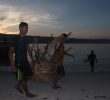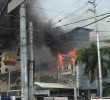Need for reintegration and development assistance
While many IDPs have been able to return in the days or weeks following their displacement and managed to restart their lives with their property, land and means of livelihood left relatively intact, hundreds of thousands of people have not been so lucky. In the wake of the large-scale military offensives of 2000 and 2003, heavy fighting caused widespread destruction of houses and property and forced the displaced into prolonged stays in hastily set-up evacuation camps or with friends and relatives. The majority of those displaced in 2003 had already gone through the same predicament three years before and they were further weakened by renewed displacement. Although the ceasefire agreement signed by the MILF and the government in July 2003 had a clear positive effect on the overall stability of the region and prevented the eruption of large military confrontations, return and reintegration remained elusive for many IDPs. In early 2007, it was estimated that some 20 per cent of the estimated 40,000 people evacuated due to fighting in Maguindanao province had been unable to return to their homes, nearly six months after being initially displaced (Oxfam, 24 January 2007). The length of displacement in the Philippines can vary considerably from a few days to several years. In May 2006, it was reported that more than 4,000 people displaced by military operations six years earlier were still displaced in Sulu province (Inquirer, 2 May 2006).
Frequent clashes continued to occur on a regular basis in areas in Mindanao with high concentrations of rebels and government forces and created new layers of displaced people, while undermining reintegration efforts of the recently returned IDPs.
Poverty exacerbated by recurrent conflict is the major factor constraining access to education in Mindanao. Literacy rates in the ARMM region stand at 71 per cent for males and 69.4 per cent for females compared to a national rate of 93.7 and 94 per cent respectively. Elementary and secondary enrolment rates are also significantly lower, with only half the rates observed at the national level. In some conflict-affected parts of Mindanao and the ARMM region, overall dropout rates reach an alarming 23 per cent and only one out of ten children completes high school in time (WB, July 2006, p. 4). For many displaced people impoverished by the loss of means of livelihood, the depletion of assets and forced to start from scratch when they return, education becomes simply unaffordable.










